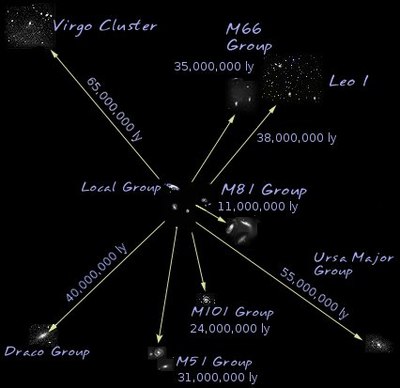Virgo Supercluster
| Virgo Supercluster | |
|---|---|

Distances from the Local Group for selected groups and clusters within the Local Supercluster
|
|
| Observation data (Epoch J2000) | |
| Redshift | Doppler shift |
| Binding mass | ~1.48 × 1015 M☉ |
| Luminosity (specify) | 3×1012L☉ |
| Other designations | |
| Local Supercluster, LSC, LS | |
| See also: Galaxy groups, Galaxy clusters, List of superclusters | |
The Virgo Supercluster (Virgo SC) or the Local Supercluster (LSC or LS) is a mass concentration of galaxies that contains the Virgo Cluster in addition to the Local Group, which in turn contains the Milky Way and Andromeda Galaxies. At least 100 galaxy groups and clusters are located within its diameter of 33 megaparsecs (110 million light-years). It is one of about 10 million superclusters in the observable universe.
A 2014 study indicates that the Virgo Supercluster is only a lobe of a greater supercluster, Laniakea, which is centered on the Great Attractor.
Beginning with the first large sample of nebulae published by William and John Herschel in 1863, it was known that there is a marked excess of nebular fields in the constellation Virgo (near the north galactic pole). In the 1950s, French–American astronomer Gérard Henri de Vaucouleurs was the first to argue that this excess represented a large-scale galaxy-like structure, coining the term "Local Supergalaxy" in 1953, which he changed to "Local Supercluster" (LSC) in 1958. (Harlow Shapley, in his 1959 book Of Stars and Men, suggested the term Metagalaxy.) Debate went on during the 1960s and 1970s as to whether the Local Supercluster (LS) was actually a structure or a chance alignment of galaxies. The issue was resolved with the large redshift surveys of the late 1970s and early 1980s, which convincingly showed the flattened concentration of galaxies along the supergalactic plane.
...
Wikipedia
